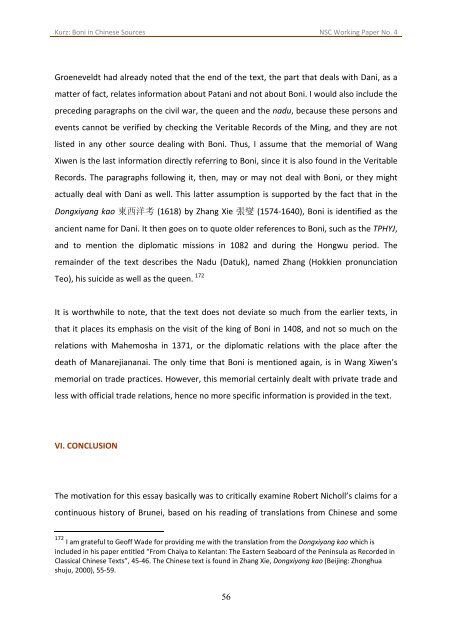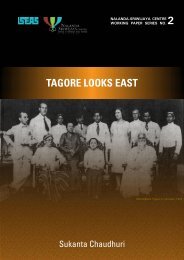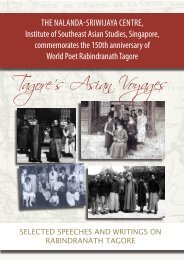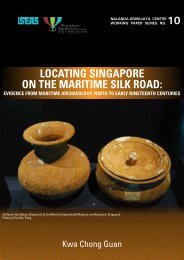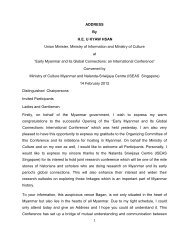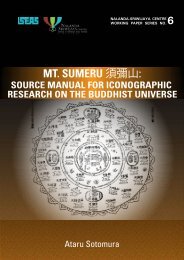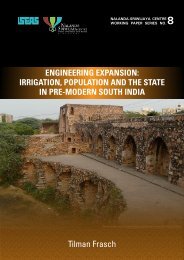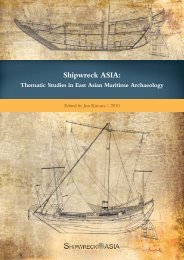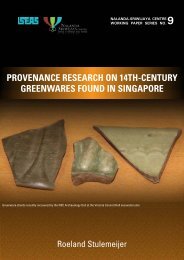Boni in Chinese Sources - Nalanda-Sriwijaya Centre - iseas
Boni in Chinese Sources - Nalanda-Sriwijaya Centre - iseas
Boni in Chinese Sources - Nalanda-Sriwijaya Centre - iseas
You also want an ePaper? Increase the reach of your titles
YUMPU automatically turns print PDFs into web optimized ePapers that Google loves.
Kurz: <strong>Boni</strong> <strong>in</strong> Ch<strong>in</strong>ese <strong>Sources</strong> NSC Work<strong>in</strong>g Paper No. 4Groeneveldt had already noted that the end of the text, the part that deals with Dani, as amatter of fact, relates <strong>in</strong>formation about Patani and not about <strong>Boni</strong>. I would also <strong>in</strong>clude thepreced<strong>in</strong>g paragraphs on the civil war, the queen and the nadu, because these persons andevents cannot be verified by check<strong>in</strong>g the Veritable Records of the M<strong>in</strong>g, and they are notlisted <strong>in</strong> any other source deal<strong>in</strong>g with <strong>Boni</strong>. Thus, I assume that the memorial of WangXiwen is the last <strong>in</strong>formation directly referr<strong>in</strong>g to <strong>Boni</strong>, s<strong>in</strong>ce it is also found <strong>in</strong> the VeritableRecords. The paragraphs follow<strong>in</strong>g it, then, may or may not deal with <strong>Boni</strong>, or they mightactually deal with Dani as well. This latter assumption is supported by the fact that <strong>in</strong> theDongxiyang kao 東 西 洋 考 (1618) by Zhang Xie 張 燮 (1574‐1640), <strong>Boni</strong> is identified as theancient name for Dani. It then goes on to quote older references to <strong>Boni</strong>, such as the TPHYJ,and to mention the diplomatic missions <strong>in</strong> 1082 and dur<strong>in</strong>g the Hongwu period. Therema<strong>in</strong>der of the text describes the Nadu (Datuk), named Zhang (Hokkien pronunciationTeo), his suicide as well as the queen. 172It is worthwhile to note, that the text does not deviate so much from the earlier texts, <strong>in</strong>that it places its emphasis on the visit of the k<strong>in</strong>g of <strong>Boni</strong> <strong>in</strong> 1408, and not so much on therelations with Mahemosha <strong>in</strong> 1371, or the diplomatic relations with the place after thedeath of Manarejiananai. The only time that <strong>Boni</strong> is mentioned aga<strong>in</strong>, is <strong>in</strong> Wang Xiwen’smemorial on trade practices. However, this memorial certa<strong>in</strong>ly dealt with private trade andless with official trade relations, hence no more specific <strong>in</strong>formation is provided <strong>in</strong> the text.VI. CONCLUSIONThe motivation for this essay basically was to critically exam<strong>in</strong>e Robert Nicholl’s claims for acont<strong>in</strong>uous history of Brunei, based on his read<strong>in</strong>g of translations from Ch<strong>in</strong>ese and some172 I am grateful to Geoff Wade for provid<strong>in</strong>g me with the translation from the Dongxiyang kao which is<strong>in</strong>cluded <strong>in</strong> his paper entitled “From Chaiya to Kelantan: The Eastern Seaboard of the Pen<strong>in</strong>sula as Recorded <strong>in</strong>Classical Ch<strong>in</strong>ese Texts”, 45‐46. The Ch<strong>in</strong>ese text is found <strong>in</strong> Zhang Xie, Dongxiyang kao (Beij<strong>in</strong>g: Zhonghuashuju, 2000), 55‐59.56


